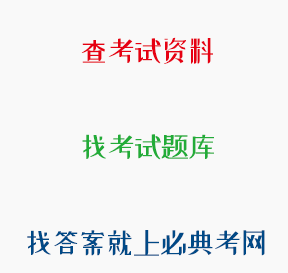正确答案: A
接受学生家长送的贵重礼物
题目:下列哪项不是《教师法》规定教师享有的权利或义务( )。
解析:《中华人民共和国教师法》规定教师享有以下权利:①进行教育教学活动,开展教育教学改革和实验;②从事科学研究、学术交流,参加专业的学术团体,在学术活动中充分发表意见;③指导学生的学习和发展,评定学生的品行和学业成绩;④按时获取工资报酬,享受国家规定的福利待遇以及寒暑假期的带薪休假;⑤对学校教育教学、管理工作和教育行政部门的工作提出意见和建议,通过教职工代表大会或者其他形式,参与学校的民主管理;⑥参加进修或者其他方式的培训。教师应当履行以下义务:①遵守宪法、法律和职业道德,为人师表;②贯彻国家的教育方针,遵守规章制度,执行学校的教学计划,履行教师聘约,完成教育教学工作任务;③对学生进行宪法所确定的基本原则的教育和爱国主义、民族团结的教育,法制教育以及思想品德、文化、科学技术教育,组织、带领学生开展有益的社会活动;④关心、爱护全体学生,尊重学生人格,促进学生在品德、智力、体质等方面全面发展;⑤制止有害于学生的行为或者其他侵犯学生合法权益的行为,批评和抵制有害于学生健康成长的现象;⑥不断提高思想政治觉悟和教育教学业务水平。"接受学生家长送的贵重礼物"违反了廉洁从教的教师职业道德,更不是《教师法》规定的教师权利或义务。故选择A。
查看原题 查看所有试题
学习资料的答案和解析:
[单选题]下列属于学习现象的是( )。
儿童模仿电影中的人物
解析:学习是个体在特定的情景下由于练习和反复经验而产生的行为或行为潜能的比较持久的改变。故选择C。A选项是由遗传决定的。B项是本能。
[单选题]皮亚杰的"三山实验"证实了儿童思维带有明显的特点,即( )。
自我中心化
解析:皮亚杰曾经做过一个"三山实验":在一个立体沙丘模型上错落摆放了三座山丘,首先让儿童从前后左右不同方位观察这座模型,然后让儿童看四张从前后左右四个方位所摄的沙丘的照片,让儿童指出和自己站在不同方位的另外一人(实验者或娃娃)所看到的沙丘情景与哪张照片一样。前运算阶段的儿童无一例外地认为别人在另一个角度看到的沙丘和自己所站的角度看到的沙丘是一样的。皮亚杰的"三山实验"证明该阶段儿童看问题往往以自我的角度为中心出发,尚没有建立完全的逻辑思维能力。
[单选题]Passage 1
In the field of psychology, there's long been a certain haziness surrounding the definition of creativity, an I-know-it-when-I-see it attitude that has eluded a precise formulation. During our conversation, Beeman told me that he used to be reluctant to tell people what his area of study was, for fear of being dismissed or misunderstood. What, for instance, crosses your mind when you think of creativity?Well, we know that someone is creative if he produces new things or has new ideas. A choreographer, an artist, a writer, a scientist, or a mathematician with a novel discovery -these are the creatives, the people who bring something new into the world. And yet, as John Kounios, a psychologist at Drexel University who collaborates frequently with Beeman, points out, that view is wrong, or at least not entirely right. "Creativity is the process, not the product:' he says.
To illustrate, Beeman offers an example. Imagine someone who has never used or seen a paperclip and is struggling to keep a bunch of papers together. Then the person comes up with a new way of bending a stiff wire to hold the papers in place. "That was very creative:' Beeman says. On the flip side, if someone works in a new field-Beeman gives the example of nanotechnology-anything that he produces may be considered inherently "creative." But was the act of producing it actually creative? As Beeman puts it, "Not all artists are creative. And some accountants are very creative."
Insight, however, has proved less difficult to define and to study. Because it arrives at a specific moment in time, you can isolate it,examine it, and analyze its characteristics."Insight is only one part of creativity:'Beeman says. "But we can measure it. We have a temporal marker that something just happened in the brain. l'd never say that's all of creativity, but it's a central, identifiable component." When scientists examine insight in the lab, they are looking at what types of attention and thought processes lead to that moment of synthesis. If you are trying to facilitate a breakthrough, are there methods you can use that help? If you feel stuck on a problem, are there tricks to get you through?
In a recent study, Beeman and Kounios followed people's gazes as they attempted to solve what's called the remote-associates test, in which the subject is given a series of words, like "pine:' "crab:' and "sauce:' and has to think of a single word that can logically be paired with all of them. They wanted to see if the direction of a person's eyes and her rate of blinking could shed light on her approach and on her likelihood of success. It turned out that if the subject looked directly at a word and focussed on it-that is, blinked less frequently, signalling a higher degree of close attention-she was more likely to be thinking in an analytical, convergent fashion, going through possibilities that made sense and systematically discarding those that didn't. If she looked at "pine:' say, she might be thinking of words like "tree:' "cone:' and "needle:' then testing each option to see if it fit with the other words. When the subject stopped looking at any specific word, either by moving her eyes or by blinking, she was more likely to think of broader, more abstract associations. That is a more insight-oriented approach. "You need to learn not just to stare but to look outside your focus:' Beeman says.(The solution to this remote-associates test."apple.")
As it turns out, by simply following someone's eyes and measuring her blinks and fixation times (how long she looks at something before either looking away or closing her eyes), Beeman's group can predict how someone will likely solve a problem and when she is nearing that solution. That's an important consideration for would-be creative minds. it helps us understand how distinct patterns of attention may contribute to certain kinds of insights.
In PARAGRAPH FOUR, which of the following shows the purpose of describing the experiment?
To discern connection between close attention and insights
解析:根据第三段”When scientists examine insight in the lab, they are looking at what types of attention and thought processes lead to that moment of synthesis",当科学家们在实验室检测洞察力时,他们所观察的是何种类型的注意力和思维过程可以带来顿悟.即实验目的是通过对比实验中两种人的观察和思维方式。反映的是注意力与洞察力之间的相互作用。故选择B。

 川公网安备 51012202001360号
川公网安备 51012202001360号